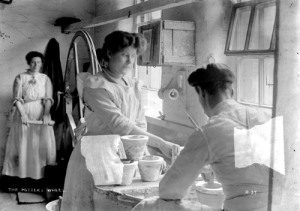The museum is the last untouched example of a North Staffordshire potbank – the small earthenware and china works which dominated the six towns of Stoke-on-Trent for more than two centuries. The six towns – Tunstall, Burslem, Hanley, Stoke, Fenton and Longton – grew up close to the outcrops of tarry coal that provided the fuel for the bottle ovens which loomed over their rooftops and choked them with ash and soot. Life in the shadow of the potbanks was hard, as was the work within them. Entire families would toil for long hours in dangerous conditions driving the many complex processes that were required to make the wares.
Thrower, turner, fettler, sponger, one legged dancer, dipper; the names of jobs in the potbank have an earthy resonance, displaying a grim humour in the face of hardship. My favourite; saggar maker’s bottom knocker is the name of the boy who bashed out lumps of coarse local clay inside an iron hoop to form the base of the saggar, a large clay vessel used to contain the ware when it was fired. It was the saggar maker himself who paid the bottom knocker a weekly wage of a pound out of his own pay, which could be as much as six pounds, but the bottom knocker had little hope of earning more for the only route to promotion was through a dead man’s shoes.
Not that he would have had long to wait, up until as late as 1900 the average age of an adult at death was 46. Thick choking smog, flint and clay dust, lead poisoning and extreme heat from the ovens all took their toll on the workers but life started to improve in the late nineteenth century as various pieces of legislation were brought in to protect the workers. Finally in 1952, the Clean Air Act forced the smoky bottle ovens to close and changed the landscape around Stoke-on-Trent forever.
Fascinating though the technical aspects of the pottery were, there was a very sombre undercurrent that could not be ignored. That was the lives and working conditions of those who laboured there. They were abysmal and hooray for those who strived to improve the lot of the workers. In the main, these were not the owners or politicians but outsiders who were appalled by what was going on. Of course, things are immeasurably better today but let's not be so complacent as to ignore the iniquities of some modern working practices. I'm thinking of zero hour contracts, sub-minimum wage jobs, unpaid internships, the gradual erosion of terms and conditions of employment and the demonisation of those who agitate for employees rights. All of these are echoes from the past and all of them, now as then, are for the benefit of the owners and shareholders. It still makes me angry. And I'm glad it does as it would be terrible not to be stirred by it.
 |
| Just a few of the many moulds made for pieces such as vases, tea pots and other items too intricate to be made directly from clay and needing to made from clay suspension or slip. |
 |
| The Colour Store where all the pigments were kept. All stored, appropriately, in porcelain jars. |
 |
| And that's me sporting a very stylish knotted hankie on my head as I enjoy a dip in my nan's tin bath with my aunty Phyll. Taken in July 1949, I was just under two years old. How time flies. |













No comments:
Post a Comment